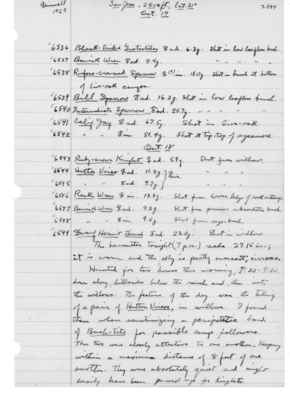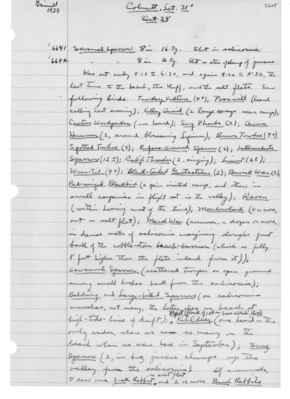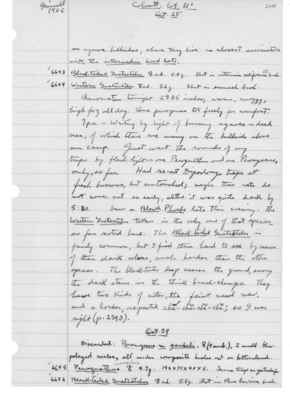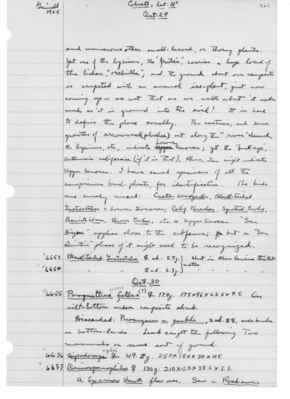Pages That Mention Black-Tailed Gnatcatcher
1925: Joseph Grinnell's field notes
S3 Page 51
Collector: Grinnell - 1925 Location: San Jose, 2500 ft., Lat. 31 degrees Date: Oct. 17 Page Number: 2594
6536 Black-Tailed Gnatcatcher (female sign) ad. 6.3g. Shot in low leafless bush. 6537 Bewick Wren (male sign) ad. 8.4.g. 6538 Rufous-crowned Sparrow (male sign)(?) im. 18.0g. Shot in bush at bottom of Live-oak canyon. 6539 Bell Sparrow (male sign) ad. 16.2g. Shot in low leafless brush. 6540 Intermediate Sparrow (male sign) ad. 25.7. Shot in low leafless brush. 6541 Calif. Jay (female sign) ad. 67.5g. Shot in live-oak. 6542 “ “ (male sign) im. 81.4 g. Shot at tip-top of sycamore.
Oct. 18 6543 Ruby-crown Kinglet (female sign) ad. 5.9g. Shot from willow. 6544 Hutton's Vireo (female sign) ad. 11.2g. } Pair “ “ “ 6545 “ “ (male sign) ad. 9.7 g. } Pair “ “ “ 6546 Rock Wren (female sign) im. 13.8g. Shot from lower ledge of rock outcrop. 6547 Bewick Wren (female sign) ad. 9.2g. Shot from prunus subcordata bush. 6548 “ “ (male sign) im. 9.5g. Shot from sage-bush. 6549 Dwarf Hermit Thrush (male sign) ad. 23.0g. Shot in willow.
The barometer tonight (7 p.m.) reads 27.15 in.; it is warm and the sky is partly overcast, cirrous.
Hunted for two hours this morning, 7:30-9:30, down along hillsides below the ranch and then into the willows. The feature of the day was the taking of a pair of Hutton's Vireo, in willows. I found them when scrutinizing a peripatetic band of Bush-tits for possible camp followers. The two were closely attentive to one another, keeping within a maximum distance of 8 feet of one another. They were absolutely quiet and might easily have been passed up for Kinglets.
S3 Page 59
S3 Page 59
Collector: Grinnell - 1925 Location: San Jose, 2500 ft., lat. 31° Date: Oct. 23 Page Number: 2602
6589 Thomomys (female sign) 123g. 207 x 58 x 29 x 5. In sandy bottom, where bermuda & salt grass grow. 6590 “ (female sign) 96g. 190 x 57 x 25 x 4. “ “ “ “ “ “
This forenoon I worked the washes and foothills north of the ranch one to two miles, against the lower range of mountains toward Socorro. In a broad shallow wash down west from those mountains found a well-marked yucca association: a kind of yucca, of stalks 6 to 8 feet high [= buccata?]; low clumps of cholla cactus, greasewood, sage-brush, some alder and rhus laurina bushes. Here I found the following birds: Shrike (one, perching from station to station in yucca tips on bare burned bush tips - too shy to approach closely enuf for a shot); Cactus Woodpecker(one, shot, on yuccas, calling characteristically, finally lit in a big desert tea bush); Black-tailed Gnatcatcher (one company of about 5, in buckwheat, greasewood and sage; kitten-like calls I now think quite like birds in Southern California; hard to see, and soon scattered and became quiet - lost); Ball Sparrow (few, about 6 all told, seemingly in pairs); Brown Towhee (2); Bewick Wren (2+); Say Phoebe (1); Intermediate Sparrow (commonest of the birds - perhaps all 25 told).
Then worked the willows down-stream from the ranch. Saw a Red-breasted and a Red-naped (shot) Sapsucker close together. Heard a Lawrence Goldfinch in flight overhead, as also a Green-backed Goldfinch. Saw one Russet-backed (?) Thrush.
S3 Page 66
Collector: Grinnell - 1925 Location: to Colnett, Sat. 31 degrees Date: Oct. 28 Page Number: 2608
6641 Savannah Sparrow (female sign) im. 16.7g. Shot in salicornia. 6642 “ “ (female sign) im. 16.8.g. Shot on stem of clump of juncus.
Was out early 5:15 to 6:30, and again 9:20 to 11:30, the last time to the beach, the bluff, and the salt flats. Saw following birds: Turkey Vulture (4+); Poorwill (heard calling last evening); Valley Quail (2 large coveys near camp); Cactus Woodpecker (one heard); Say Phoebe (2); Anna Hummer (2, around blossoming Lycium); Brown Towhee (4+); Spotted Towhee (2); Rufous-crowned Sparrow (2); Intermediate Sparrow (12±); Calif. Thrasher (2, singing); Linnet (6±); Wren-tit (4+); Black-Tailed Gnatcatcher (2); Bewick Wren (2); Red-winged Blackbird (a pair visited camp, and others in small companies in flight out in the valley); Raven (within hearing most of the time); Meadowlark (4 or more, out in salt flat); Marsh Wren (common, a dozen or more, in dense mats of Salicornia (unknown 1) sloughs just back of the cobble-stone beach-barrier (which is fully 8 feet higher than the flats inland from it)); Savannah Sparrow (scattered troupes on open ground among small bushes back from the salicornia); Belding and Large-billed Sparrows (on salicornia marshes, not many, the latter also on beach at high-tide line of drift); Pipit (flock of 10± on bare alkali flat); Killdeer (one heard - the only wader, where we saw so many on the beach when we were here in September); Song Sparrow (2, in big juncus clumps up the valley from the salicornia. Of mammals, I saw one Jack Rabbit on salt flat and 2 or more Brush Rabbits.
S3 Page 67
Collector: Grinnell - 1925 Location: Colnett, Sat. 31 degrees Date: October 28, 1925 ?Page Number: 2609
on agave hillsides, where they live in closest association with the intermedia wood rats.
6643 Black-Tailed Gnatcatcher (female sign) ad. 5.8g. Shot in artemesia californica (?) bush. 6644 Western Gnatcatcher (male sign) ad. 5.6g. Shot in sumach bush.
Barometer tonight 29.85 inches; warm, muggy; high fog all day. One perspires too freely for comfort. 7 p.m. - Writing by light of of burning agaves- dead ones, of which there are many on the hillside above our camp. Just went the rounds of my traps by flash light - one Perognathus and one Peromyscus, only, so far. Had re-set Dipodomys traps at fresh burrows, but untouched; maybe these rats do not come out so early, altho it was quite dark by 5:30. Saw a Black Phoebe late this evening. The Western Gnatcatcher taken is the only one of that species so far noted here. The Black-Tailed Gnatcatcher is fairly common, but I find them hard to see by reason of their dark colors, much harder than the other species. The black-tails keep nearer the ground, among the dark stems in the thick brush-clumps. They have two kinds of notes, the faint nasal mew, and a louder, repeated che-che-che-che; so I was right (p. 2593).
Oct. 29 Discarded: Peromyscus m. gambeli, (female sign) (4 emb.), 2 small blue pelaged males, all under composite bushes out on bottomland. 6645 Perognathus arenarius (male symbol) 9.7g. 142 x 71 x 20 x 5. Same trap as yesterday’s. 6646 Black-Tailed Gnatcatcher (male symbol) 5.8g. Shot in Rhus laurina bush.
S3 Page 69
Collector: Grinnell - 1925 Location: Colnett, lat. 31 degrees Date: October 29, 1925 Page Number: 2611
and numerous other small-leaved, or thorny plants. Yet one of the lyciums, the “frutéa,” carries a huge load of the lichen, “orchilla”; and the ground about hour campsite is carpeted with an annual ice-plant, just now coming up - so wet that as we walk about it makes mud as it is ground into the soil! It is hard to define the place zonally. The cactus, and dense growths of arrowweed (pluchea) out along the “river” channel, the lyciums, etc., indicate Lower Sonoran; yet the “buck-eye”, artemisia californica (if it is that), Rhus, etc., might indicate Upper Sonoran. I have saved specimens of all the conspicuous bush plants, for identification. The birds are surely mixed: Cactus Woodpecker, Black-Tailed Gnatcatcher = Lower Sonoran; Calif. Thrasher, Spotted Towhee, Bewick Wren, Brown Towhee, etc. = Upper Sonoran. “San Diegan” applies close to the sub fauna; but a “San Quentin” phase of it might need to be recognized.
6653 Black-Tailed Gnatcatcher (female sign) ad. 5.7g. 6654 “ “ (male sign) ad. 6.3g. Shot in Rhus laurina thickets. mates.
Oct. 30 6655 Perognathus fallax (?) (female sign) 17.4g. 175 x 96 x 23.5 x 4.5 On silt-bottom under composite shrub. Discarded: Peromyscus m. gambeli, 2 ad. (male sign) (male sign), under bushes on bottomlands. Lamb caught the following two mammals on same sort of ground. 6656 Dipodomys agilis (female sign) 49.2g. 257 x 150 x 38 x 115. 6657 Ammospermophilus (female sign) 130g. 210 x 53 x 38.5 x 5.5. A Sparrow Hawk flew over. Saw a Roadrunner




